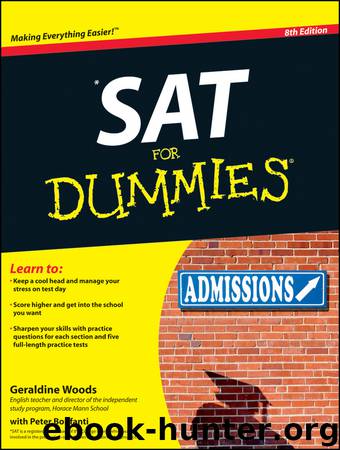SAT For Dummies, 8th Edition by Woods Geraldine & Bonfanti Peter & Josephson Kristin

Author:Woods, Geraldine & Bonfanti, Peter & Josephson, Kristin [Woods, Geraldine & Bonfanti, Peter & Josephson, Kristin]
Language: eng
Format: epub
Tags: Itzy, Kickass.so
ISBN: 9781118102084
Amazon: B006CDCPD4
Publisher: For Dummies
Published: 2011-11-16T05:00:00+00:00
The final answer, 1.5625, is the same as 19⁄16.
4. D. First off, you must realize that the set contains 21 numbers, not 20. Remember that to find the size of a list of numbers, you subtract the first and last numbers and then add one. (Count them if you don’t believe me.) Now, the even numbers are 20, 22, . . . up to 40, which makes five numbers in the 20s, five in the 30s, and 40, which makes 11 numbers out of 21.
5. E. All the numbers have three digits. Only Choices (A), (D), and (E) have a units (ones) digit that equals the sum of the other two digits. And, using a calculator, you can see that the square roots of 156 and 516 are decimals, while the square root of 729 is 27, which makes it your answer.
6. D. A slope of –1⁄3 means that the line goes down 1 space every time it moves 3 spaces to the right. Because point M is on the x-axis, the line has gone down 2 spaces by the time it reaches M, so it must have moved 6 spaces to the right. In other words, point M is at (5, 0). Point M is the midpoint of the line, which means that it’s halfway to point P. So to get to point P, you need to move another 2 spaces down and 6 spaces right, which puts you at (11, –2).
7. C. Because b + c = x, b = x – c. So you can substitute (x – c) for b in the first equation, and write a(x – c) = n. Because of the parentheses, you have to use the distributive law to get ax – ac = n, which is Choice (C).
8. D. Possible numbers for g are numbers like 3, 6, 12, 15, 21, and so on. If you try multiplying these numbers by 7 and then dividing by 9, you discover that the remainder is always 3 or 6. Because 3 isn’t one of your choices, 6 is the right answer.
9. D. A lot of these answers look true. However, if you let a equal 1, or a number less than 1, you realize that most of them become false. This question is an old SAT trap; numbers between zero and one (such as fractions) behave in funny ways. The only statement that is true for all positive numbers is Choice (D): Twice any positive number must be bigger than the original number.
10. E. Because this problem involves parallel lines, you need to look for angles that are congruent. You can find them by looking for lines that make a Z or a backwards Z. Looking first at the bigger triangles, you can mark the diagram as follows:
Download
This site does not store any files on its server. We only index and link to content provided by other sites. Please contact the content providers to delete copyright contents if any and email us, we'll remove relevant links or contents immediately.
The Art of Coaching Workbook by Elena Aguilar(50767)
Trainspotting by Irvine Welsh(21464)
The Secret History by Donna Tartt(18775)
Twilight of the Idols With the Antichrist and Ecce Homo by Friedrich Nietzsche(18460)
All the Missing Girls by Megan Miranda(15426)
Cat's cradle by Kurt Vonnegut(15116)
Ready Player One by Cline Ernest(14457)
Talking to Strangers by Malcolm Gladwell(13146)
Fangirl by Rainbow Rowell(9038)
The remains of the day by Kazuo Ishiguro(8764)
Thirteen Reasons Why by Jay Asher(8750)
The Compound Effect by Darren Hardy(8742)
Tools of Titans by Timothy Ferriss(8165)
Periodization Training for Sports by Tudor Bompa(8106)
Wonder by R. J. Palacio(7884)
The Lover by Duras Marguerite(7763)
Change Your Questions, Change Your Life by Marilee Adams(7575)
A Court of Wings and Ruin by Sarah J. Maas(7570)
The Complete Stick Figure Physics Tutorials by Allen Sarah(7275)
